Bread (satellite)
In astronomy, Pan is one of the moons of the planet Saturn, also called Saturn XVIII. It is the innermost of the known satellites of this planet (just 133,583 km from the center of Saturn), and is located in the Encke division of Saturn's A ring, for which it acts as a shepherd moon, being responsible for keeping it open. It was discovered by Mark R. Showalter in 1990 that it causes the separation of Saturn's rings while examining old photographs taken nine years earlier by Voyager's encounter with Saturn. Pan is known as the "moon ravioli", due to its peculiar shape to a small ravioli pasta patty.
Pan also, in Greek mythology, was the satyr god of the forests, fields and fertility, son of Hermes, messenger of the Olympian gods, and of a nymph also of the forests.
Prediction
The existence of a satellite in the Encke Divide was predicted by Jeffrey N. Cuzzi and Jeffrey D. Scargle in 1985, based on the wavy edges of the divide indicating gravitational distortion. In 1986 Showalter and his team inferred their orbit and mass modeling its gravitational wake. They arrived at a very accurate prediction of 133.603 ± 10 km for the semimajor axis and a mass of 5–10×10−12 Saturn masses, and inferred that there was a single satellite within the division. The current semi-major axis differs by only 19 km and the current mass is 8.6×10−12 Saturn masses.
The satellite was later found at the first predicted position. The search was performed considering all Voyager 2 images and using computational calculations to predict whether the satellite would be visible under favorable conditions in each of them. Every qualified Voyager 2 image with resolution better than ~50 km/Pixel shows Pan clearly. Among all, it appears in eleven images of Voyager 2.
Orbit
Pan's orbital eccentricity causes the distance between it and Saturn to vary by about 4 kilometers. Its orbital inclination, which should cause it to bob up and down, is not distinguishable from zero with current data. The Encke Divide, in which Pan orbits, is about 200 miles wide.
Geography
Scientists at Cassini have described Pan as walnut-shaped due to the equatorial ridge, similar to that of the Atlas satellite, which is visible in the images. The ridge is due to material from Saturn's ring that has been swept up from the Encke Divide.
Bread Ring
The Encke rift contains a ring that is coincident with Pan's orbit, indicating that Pan keeps the particles in a horseshoe orbit.
Name
The satellite was named on September 16, 1991 after the mythological figure Pan, who was (among other things) the god of shepherds. This is a reference to Pan's role as the shepherd satellite. It is also designated as Saturn XVIII.
It was discovered by Mark R. Showalter in 1990 while analyzing old photos from the Voyager 2 probe and given its provisional designation S/ 1981 S 13 because the discovery images were dated 1981.
There is also an asteroid called (4450) Pan.
Contenido relacionado
Antares
Cygnus (constellation)
Auriga (constellation)


